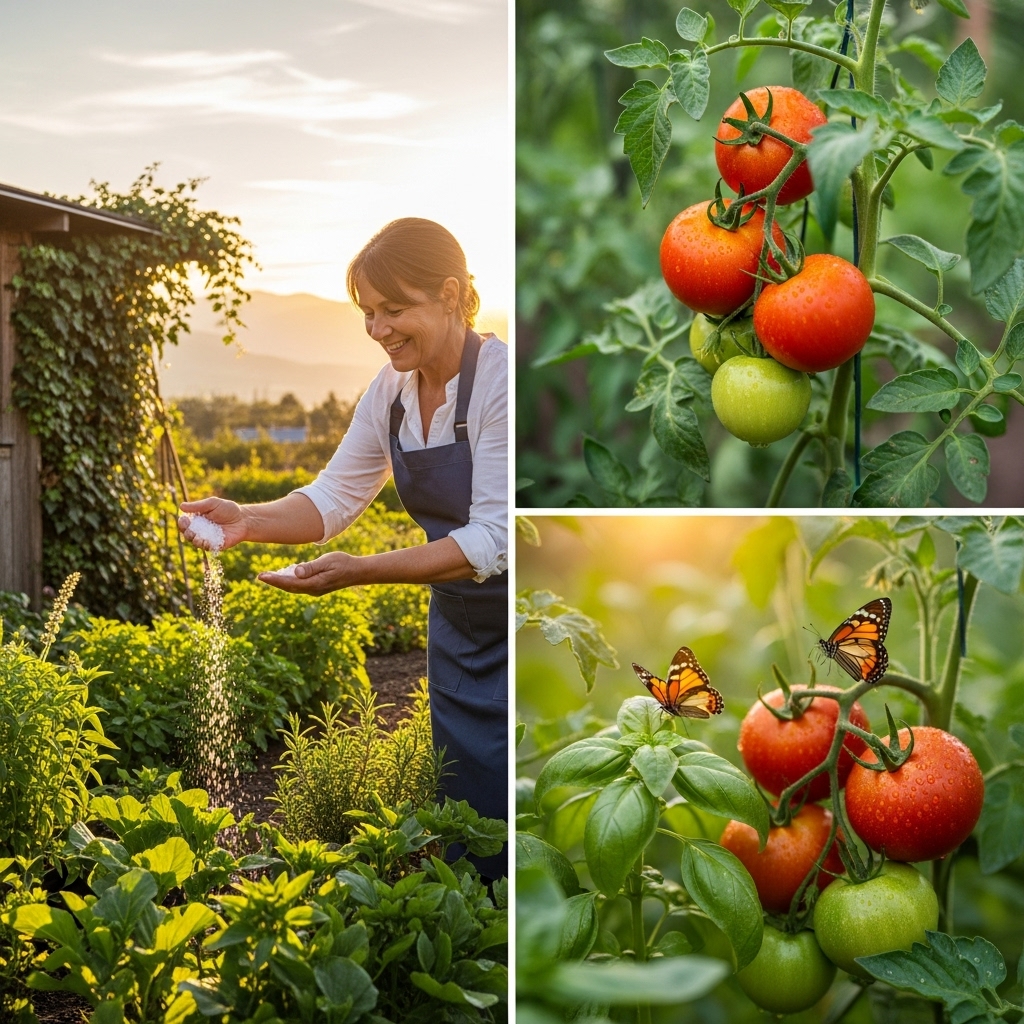As a passionate gardener, I’ve discovered that a simple, low-cost ingredient can transform my garden. Epsom salt isn’t just for relaxation; it’s a powerhouse for plants when used correctly. Let’s explore how this garden hack can yield high-impact results!
Understanding Epsom Salt and Its Benefits

When I first stumbled upon Epsom salt, I was skeptical. I mean, how could a product that I associated with soothing baths possibly benefit my garden? However, I decided to dive deeper into what Epsom salt is and how it works. Composed of magnesium sulfate, Epsom salt is rich in magnesium—an essential nutrient for plants. Magnesium plays a pivotal role in photosynthesis, which is the process that plants use to convert sunlight into energy. Without adequate magnesium, plants can struggle to thrive, and I learned that this essential mineral also aids in the absorption of other nutrients like nitrogen and phosphorus.
One of the most significant benefits I experienced was how Epsom salt improved the overall health of my plants. For instance, after applying it to my tomato plants, I noticed an increase in fruit production and better flavor. The added magnesium seemed to give them a boost, making them more robust and resistant to diseases.
How Epsom Salt Affects Different Plants
What I found fascinating was that Epsom salt isn’t just a one-size-fits-all solution; its benefits vary among different types of plants. For example, I learned that roses thrive when given Epsom salt because it encourages new growth and vibrant blooms. The same goes for peppers and other flowering plants. In my experience, a simple application of Epsom salt can lead to more colorful and plentiful flowers, which is a huge win for any gardener.
Similarly, I discovered that certain vegetables, like cucumbers and squash, benefit significantly from Epsom salt as well. These plants often require higher levels of magnesium to produce healthy yields. When I started incorporating Epsom salt into my gardening routine, I noticed that my cucumbers were not only larger but also had a crisper texture. It was a delightful change that certainly made my salads more enjoyable!
When and How to Apply Epsom Salt
Timing is crucial when it comes to applying Epsom salt. I’ve found that there are several key moments throughout the growing season when Epsom salt can be particularly beneficial. When planting, I mix a tablespoon of Epsom salt into the soil in the planting hole for new plants. This gives them an initial magnesium boost right from the get-go. Additionally, during the growing season, I apply Epsom salt every four to six weeks, especially to my fruit-bearing plants. This routine has helped keep my garden flourishing.
Application methods vary, and I’ve experimented with a few. One of the easiest ways is to dissolve Epsom salt in water, creating a foliar spray. I mix about two tablespoons of Epsom salt in a gallon of water and spray it directly onto the leaves of my plants. This method allows for quick absorption. I often notice a difference in the plants’ vigor within a few days. Another method I prefer is to sprinkle dry Epsom salt around the base of the plants and then water it in. This slow-release approach ensures that the magnesium seeps into the soil gradually.
Potential Risks and Misuse
While Epsom salt can work wonders, I’ve learned that it’s essential to use it responsibly. Over-application can lead to nutrient imbalances. My advice is to start small and observe how your plants respond. If you notice any signs of distress, such as yellowing leaves or stunted growth, it may be time to reevaluate your Epsom salt use.
Additionally, not all plants require extra magnesium. Some plants, such as potatoes, may not benefit from Epsom salt, so it’s worth researching specific needs. I’ve made the mistake of assuming all plants would thrive with this addition, only to find that some responded poorly. Therefore, I always consider the unique requirements of each plant before applying Epsom salt.
Alternative Uses Beyond the Garden
You might be surprised to learn that Epsom salt isn’t just a gardening marvel; it has several other applications that I’ve found useful. For instance, I often use it in my home for various purposes. It can be a great addition to bathwater to soothe sore muscles or as a natural exfoliant for the skin. I even learned that Epsom salt can be used in cleaning; it works wonders in scrubbing surfaces because of its coarse texture. This versatility makes Epsom salt a staple in my home and garden.
Embracing Epsom salt in my gardening journey has truly been a game changer. The simplicity of its use, coupled with its high-impact results, makes it an invaluable resource for any gardener, whether a novice or a seasoned pro. By understanding how to apply it correctly and observing my plants’ needs, I continue to reap the benefits of this remarkable garden hack.
Combining Epsom Salt with Other Garden Techniques

As I continued my gardening journey, I realized that Epsom salt works exceptionally well when combined with other gardening techniques. For example, I started to incorporate companion planting—a method where certain plants are grown together to enhance each other’s growth. I found that using Epsom salt alongside companion planting strategies can amplify the benefits significantly. For instance, I paired my tomatoes with basil, and after adding Epsom salt, both plants thrived beautifully. The basil seemed to flourish, growing lush and aromatic, while the tomatoes produced an abundant harvest.
Another method I experimented with is mulching. Applying Epsom salt before laying down a layer of organic mulch created a nutrient-rich environment that my plants loved. I used organic materials like straw and wood chips, and the combination of mulching and Epsom salt helped retain moisture while releasing nutrients gradually into the soil. I noticed that my plants were more resilient during dry spells, and their growth was noticeably more vigorous. It’s incredible how two simple practices can work in harmony to produce such fabulous results.
Soil Testing and Epsom Salt
Before diving into the world of Epsom salt, I learned the importance of soil testing. It’s easy to get caught up in the excitement of adding new nutrients, but understanding the current state of my soil was crucial. By conducting a soil test, I could accurately gauge the levels of magnesium, potassium, and other essential nutrients. This knowledge allowed me to tailor my Epsom salt application accordingly. For example, if my soil test revealed adequate magnesium levels, I would hold back on using Epsom salt and focus on other amendments instead.
In my experience, soil tests are a valuable investment for any serious gardener. They provide insights that inform not just Epsom salt usage but all nutrient applications. I often recommend testing the soil at least once a year, especially before starting a new gardening season. This proactive approach has allowed me to maximize my garden’s potential by ensuring that every plant receives what it specifically needs.
Making Homemade Fertilizer with Epsom Salt
Another exciting discovery was blending Epsom salt into homemade fertilizers. I started making my own compost and realized that adding Epsom salt to the mix enhanced the nutrient profile of my compost. By mixing a cup of Epsom salt into a batch of compost, I created a nutrient-rich amendment that I could use throughout my garden. This homemade fertilizer not only provided magnesium but also improved the overall health of my soil, promoting a thriving ecosystem.
I also experimented with creating a banana peel fertilizer. After reading about the benefits of potassium for plants, I combined dried banana peels with Epsom salt in a blender. This mixture became a fantastic fertilizer that I sprinkled at the base of my plants. The dual benefit of magnesium from Epsom salt and potassium from banana peels created a powerhouse blend that launched my plants to new heights.
Observing Plant Responses
One of the most rewarding aspects of my gardening journey has been observing how my plants respond to Epsom salt. Every plant has its unique personality, and I’ve learned to pay close attention to their reactions after applying Epsom salt. For example, I noticed that my leafy greens, like spinach and kale, responded particularly well. The leaves became more vibrant and crisp, a sign that they were soaking up the magnesium effectively.
I also took note of my flowering plants. After using Epsom salt, I observed that the blooms were not only more abundant but also more vibrant in color. This visual cue indicated that the plants thrived and emphasized the importance of magnesium in their growth. I often marvel at the beauty of my garden, which is a reflection of the careful practices I’ve adopted, including the use of Epsom salt.
Sharing Knowledge with Fellow Gardeners
As I gained more experience with Epsom salt, I felt compelled to share my knowledge with fellow gardening enthusiasts. I started hosting small gatherings in my backyard where we could exchange tips and tricks. I shared my experiences with Epsom salt, and I was amazed at how receptive everyone was. Many had never considered using Epsom salt in their gardens, and it felt fulfilling to introduce them to such a simple yet effective solution.
Through these gatherings, I learned that community plays a significant role in gardening. Swapping stories and advice not only helped me grow my garden but also fostered friendships and connections. It’s gratifying to see others benefit from the same practices that have transformed my gardening experience.
Final Thoughts
The journey of integrating Epsom salt into my gardening practices has been enlightening and fulfilling. From enhancing plant health to creating homemade fertilizers, the versatility of this simple ingredient continues to surprise me. By respecting the unique needs of each plant and sharing my findings with others, I’ve built a thriving garden that I take immense pride in. Whether you’re a novice or a seasoned gardener, I hope my experiences inspire you to explore the benefits of Epsom salt in your gardening endeavors.
